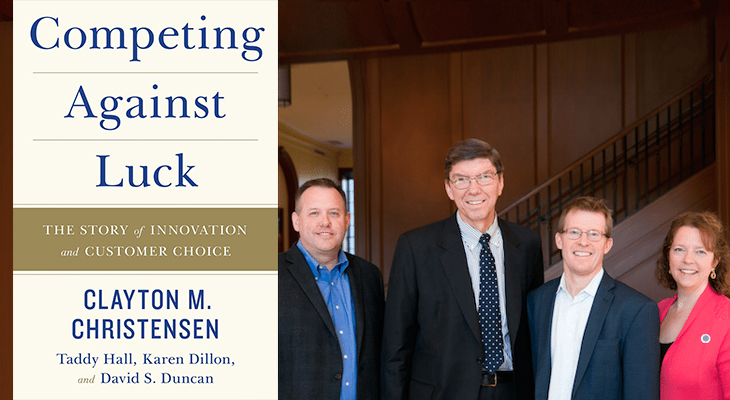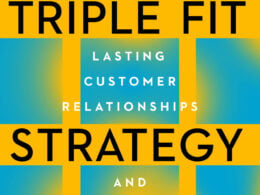The following excerpt is adapted from “Competing Against Luck: The Story of Innovation and Customer Choice” Copyright © 2016 by Clayton Christensen, Karen Dillon, Taddy Hall and David S. Duncan. Published by Harper Business, an imprint of Harper Collins Publishers.
In the mid-1990s, two consultants from Detroit asked if they could visit my office at Harvard Business School to learn more about my then newly-published theory of disruptive innovation. Bob Moesta and his partner at the time, Rick Pedi, were developing a niche business advising bakeries and snack food companies on developing new products that people would predictably buy.
As we discussed the theory, I could see that it could tell me very clearly what the established companies in the market would do in the face of an impending disruption from small bakers and snack food companies, but as we talked, it became clear that the theory of disruption did not provide a roadmap for their clients. It does not offer a clear and complete causal explanation of what a company should do offensively to be successful; if you do this and not that, you will win.
As I’d been focused on understanding why great companies fail, I realized I had never really thought about the reverse problem.
How do successful companies know how to grow?
It wasn’t for months that I would finally have an answer. Moesta shared with me a project for a food fast chain: how to sell more milkshakes. The chain had spent months studying the problem in incredible detail. They tried many things in response to customer feedback, innovations specifically intended to satisfy the highest number of potential milkshake buyers. Within months, something notable happened: Nothing.
So we thought of approaching the question in a totally different way: “I wonder what job arises in people’s lives that causes them to come to this restaurant to ‘hire’ a milkshake?”
Armed with that perspective, the team found itself standing in a restaurant for 18 hours one day, watching people: what time did people buy these milkshakes? What were they wearing? Were they alone? Did they buy other food with it? Did they eat it in the restaurant or drive off with it?
It turned out that there were a surprising number of milkshakes sold before 9am to people who came into the fast food restaurant alone. So we asked them: “Excuse me please, but I have to sort this puzzle out. What job were you trying to do for yourself that caused you to come here and hire that milkshake?”
It soon became clear that the early-morning customers all had the same job to do: they had a long and boring ride to work. As the team put all of these answers together and looked at the diverse profiles of these people, another thing became clear: what these milkshake buyers had in common had nothing to do with their individual demographics. Rather, they all shared a common job they needed to get done in the morning: help me stay awake and occupied while I make my morning commute more fun. We had the answer!
Related: Competing Against Luck [StartupNation Originals video]
Alas, it wasn’t that simple. Turns out, plenty of milkshakes are purchased in the afternoon and evening, outside of the context of a commute. In those circumstances, the same customers could hire a milkshake for a completely different job.
And therein lies the ‘aha’.
For me, framing innovation challenges through the lens of jobs customers are trying to get done was an exciting breakthrough. It offered what the theory of disruption couldn’t: an understanding of what causes customers to pull products or services into their lives.
You may be asking if Jobs Theory is so powerful, why aren’t more companies using it already? First, the definition of what we mean by a ‘job’ is highly specific and precise. It’s not an all-purpose catch phrase for something that a customer wants or needs. It’s not just a catchy buzzword. Finding and understanding jobs — and then creating the right product or service to solve them — takes work.
Identifying and understanding the job to be done is the foundation, but it’s only the first step. There are multiple layers to the Jobs Theory construct to ensure that you create products that customers will not only want to buy, but products they’re willing to pay premium prices for, Discovering the job is key, but it’s just the beginning.
After you’ve uncovered and understood the job, you create a ‘job spec’ that identifies what will matter to the customer in solving his or her job. This is how you distinguish your offering from all other possible competitors.
But to do all this well takes a holistic effort – from the original insight that led to the identification of the job all the way through to the product finding its way into the hands of a consumer – involving the decisions and influence of virtually everyone in the company. Even great innovators who are crystal clear on the jobs their customers are hiring their products and services to do can easily lose their way. Pressures of return on net assets (RONA), well-intended efficiency drives, and decisions made every day on the front lines of business can have a profound effect on the successful (or unsuccessful) delivery of a great solution to a job. There are so many ways to stumble on the journey. But the payoff for getting it right is enormous.
Related: Sign up to receive the StartupNation newsletter!
“Competing Against Luck” is available now at StartupNation.com and wherever fine books are sold.






